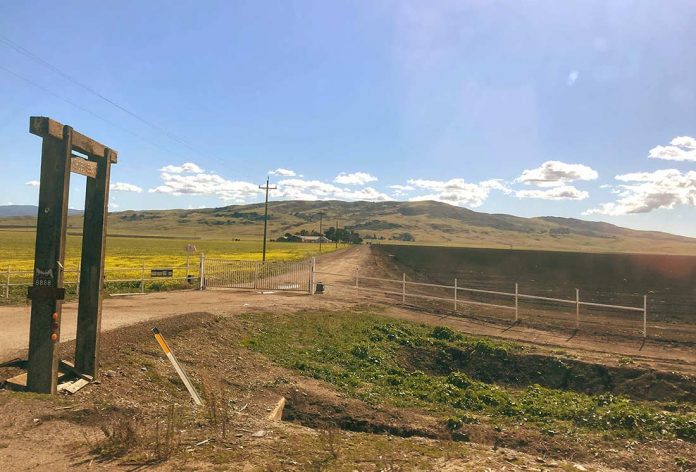
Arguing that county officials and an out-of-town developer have ignored the voice of the voters over the last two years, a group of local residents has been circulating a petition to place a measure on the Nov. 8 ballot that would limit or prohibit new construction in a large swath of northern San Benito County land.
The petition proponent, Frank Barragan, began collecting signatures for the initiative in March. The initiative’s lengthy title is, “Initiative to amend the San Benito County General Plan Health and Safety Elementy Policy HS-6.9: Sensitive uses near industrial facilities and to establish a 3.5-mile buffer around certain facilities.”
Specifically, Barragan and other proponents want a 3.5-mile buffer around TriCal, Inc.’s chemical storage and blending facility on Highway 25. Doing so would prevent the construction of the 2,777-acre Strada Verde Innovation Park commercial proposal near the intersection of Highways 101 and 25, according to Barragan.
“In November 2020, the public spoke loud and clear that they did not want the Strada Verde development,” Barragan said, referring to the results of Measure N in the 2020 election. “The arguments at that time revolved around the health and safety of San Benito County residents as well as the overall impact to traffic in the region. Now we are less than two years later and Strada Verde is proposing another development at the same location.”
Measure N would have established the Strada Verde Specific Plan at the site, allowing developer Newport Pacific Land Co. to bypass the county planning commission and board of supervisors in gaining project approval. Since then, the developer has moved the project through the county’s normal planning process. The Strada Verde proposal is currently undergoing an environmental study.
The buffer zone initiative also refers to a study commissioned by the county in 2020—months before the Measure N vote—that recommended Strada Verde be built at least 3.5 miles away from TriCal due to the potential hazards resulting from an accidental chemical spill from the facility. The entire Strada Verde proposal is located less than 3.5 miles from TriCal.
“This initiative is about making sure that any proposal going forward has the blessing of the San Benito County voters,” Barragan said of the current buffer zone petition. “It’s about ensuring the safety of our families, children and workers in San Benito County. They should not face exposure to deadly chemicals.”
The initiative’s ballot title and summary, drafted by the county counsel’s office, says the initiative would set a 3.5-mile buffer “between sensitive uses and facilities authorized to receive, handle, blend or distribute bulk-scale amounts of chloropicrin, methyl bromide or similar soil fumigants.”
The General Plan already has a buffer zone requirement between certain types of properties, but the initiative would make the wording more specific.
TriCal, which was founded in 1961, distributes agricultural fumigants such as chloropicrin and methyl bromide throughout the nation. The Hollister facility, located at 8770 Bolsa Road off of Highway 25, has consistently operated in compliance with no violations, according to five-year data by the United States Environmental Protection Agency.
An employee at the TriCal facility declined to comment about the buffer zone petition when contacted recently.
The county’s report in 2020, conducted by EMC Planning Group, found that an unexpected release of chemicals in the air from TriCal—whether by system failure, human error, act of terrorism or other cause—could cause a hazardous zone of roughly six miles surrounding the facility. According to the report, that zone extends into the southwestern portion of Gilroy and the northern tip of Hollister.
Barragan added that the initiative would help TriCal as well, preventing new projects from interfering with its business.
“The buffer works two ways. It prevents a new development from being built dangerously close to a chemicals plant,” Barragan said. “It also protects the chemicals plant from encroachment by development so it can continue to operate safely.”
Additional proponents of the buffer zone initiative are Karla Arevalo Perez and Maria Lamberson.
Barragan said proponents have collected more than 5,000 signatures from San Benito County voters, and he is confident it will either be adopted or make it to the Nov. 8 ballot.
The proponents submitted the completed petition to the elections office earlier this month, but Assistant County Counsel Joel Ellinwood said it will not be processed in time for the next board of supervisors meeting, which is June 28. The next meeting is scheduled for Aug. 9.
In San Benito County, a citizens’ initiative must collect at least 2,060 signatures of registered local voters, according to the county counsel’s office. Once a proponent has met this threshold, they must submit the petition to the county elections office for verification of signatures.
If enough signatures are verified, the county board of supervisors is tasked with certifying the petition. The board could then adopt the measure as an ordinance, place it on the next election ballot or defer either of these actions for 30 days to conduct an initiative impact study.
The county’s deadline to place a measure on the Nov. 8 ballot is Aug. 12.
The Strada Verde Innovation Park proposal includes a 1,077-acre technology testing grounds, 127-acre research park, 253-acre ecommerce use, 24-acre commercial site, 227 acres of agriculture, a 252-acre greenway, Pajaro River preserve, a habitat preserve and nearly 300 acres of infrastructure, water storage and right-of-way, according to a county notice.
The buffer zone initiative would only apply to areas within San Benito County. The Strada Verde proposal area is near the Santa Clara County border.
If the buffer zone initiative makes it to the Nov. 8 ballot, there could be two local measures in the upcoming election. The other is titled “Let the Voters Decide How San Benito Grows,” and would remove commercial “node” designations from the county zoning code, and require future voter approval for requests to rezone agricultural, rangeland or rural property in San Benito County.
The supervisors certified the Let the Voters Decide petition at the June 14 meeting, and ordered an impact study to be completed within 30 days.







